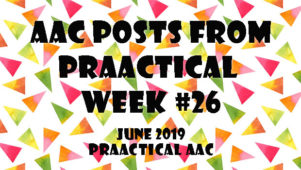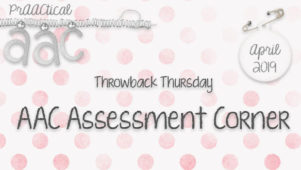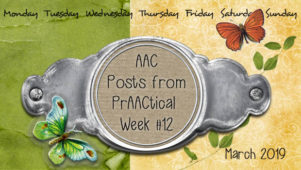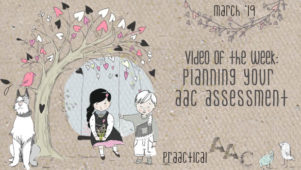AACtual Therapy with Jeanne Tuthill: AAC Assessment Activity
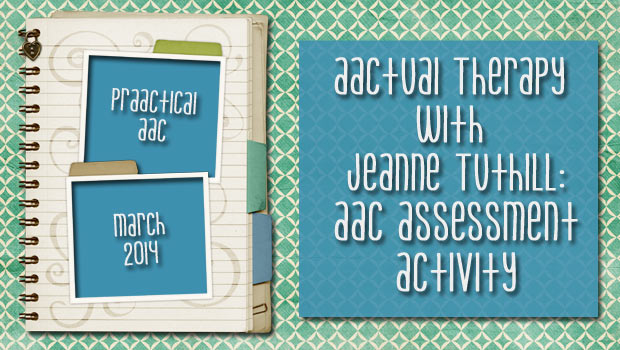
We’re so excited to introduce a new AACtual therapist, Jeanne Tuthill. Jeanne has been an SLP for over 15 years and has specialized in AAC for the past 6 years. As an AT specialist for the Collaborative Center for Assistive Technology and Training (CCATT) in Northampton, Massachusetts, Jeanne evaluates and provides consultation services for K-12 students in schools throughout Western
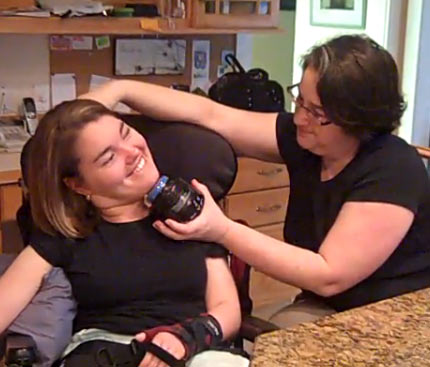 Massachusetts. In addition, she provides workshops and professional development training in that region. Since 2012, Jeanne has served as an adjunct faculty member for the Assistive Technology Graduate Program at Simmons College. She has also presented at a number of regional and national conferences. You can see Jeanne here with her long-time student Lauren Suprenant, who is using a Step-by-Step Communicator, to share information about how she communicates with others (introduction strategy).
Massachusetts. In addition, she provides workshops and professional development training in that region. Since 2012, Jeanne has served as an adjunct faculty member for the Assistive Technology Graduate Program at Simmons College. She has also presented at a number of regional and national conferences. You can see Jeanne here with her long-time student Lauren Suprenant, who is using a Step-by-Step Communicator, to share information about how she communicates with others (introduction strategy).
Jeanne shares a little bit about her work and then discusses an activity that is used in their AAC assessments.
In my current position at CCATT, I am fortunate to work with an amazing team that consists of a Physical Therapist, Psycho-educational Therapist, Special Education teacher, and SLP (me!). The CCATT center was created over 15 years ago, and one of the founding tenets of the center was a belief in the value of multiple interdisciplinary perspectives. Having worked in this environment and having seen outstanding results from integration of differing perspectives I firmly hold that same belief.
In our center, evaluations have always been conducted by professionals from at least two disciplines who each provide a valuable and differing perspective based on a given student’s profile. If appropriate we also have the ability to occasionally bring in a third (or even fourth!) discipline with its accompanying perspective from within our larger organization. Working within the framework of an interdisciplinary team I have gained an incredible amount of knowledge regarding evaluation strategies for students with Complex Communication Needs (CCN). Within this population success is frequently dependent on the input and perspectives of practitioners from multiple disciplines along with parents and other caregivers who can provide a “whole child” approach to assessment.
One of the unfortunate drawbacks of being a contract agency providing evaluation services to area schools is that often we first meet a student at the start of the evaluation. This can, at times, make it difficult to know how to proceed with the evaluation process. Intake information can only provide us a rough outline of what to expect from a particular student. Additionally, students typically perform best in a familiar environment – so while on-site evaluations are preferable we frequently perform evaluations at our center. Despite these challenges, we are often able to provide a valuable perspective based on our interdisciplinary approach as well as a few things that we always keep in mind during our evaluation process:
1) Presume competence – Know that all students communicate at some level. During the evaluation we are there to find their current communication level and try approaches, strategies and supports that will further develop or enhance their communication skills.
2) Focus on the act of communication – Use activities that are highly motivating to the student whenever possible, but be sure to keep the primary focus on what the student is communicating, what form(s) that communication takes, and what strategies allow us to communicate most effectively with the student.
3) Have a plan, but be flexible! Have a plan or schedule to help you stay focused during the evaluation process. However, sometimes the student has other ideas for the session. Being ready with alternative activities can sometimes save the day!
4) Record the session – Not only will this make writing the report a bit easier but having a video to review after the evaluation can be helpful in a few different ways. Videos help us:
- Notice patterns of communication intents (such as attention-getting signals) or other communication attempts that might have been overlooked
- Critique our own communication style during the evaluation so that hopefully we learn from our mistakes.
- Provide a wonderful learning tool to share with the student’s team. They say a picture is worth a thousand words. If so, how many words is a video worth when we can give a team a great model of effective communication strategies for their student?
Over the years I have worked at the CCATT center the team and I have collectively created a number of activities that can provide a good deal of information about a student’s communication and access abilities. In this and future blog posts I plan to share some of the activities we use in our evaluation process, what kinds of students we might use them with, and what specifically we look for when doing each activity.
Activity: Interview
This activity is a great “ice-breaker” activity particularly for students who might feel some level of anxiety about working with a new person/evaluator or who may feel some level of performance anxiety at the start of an evaluation. We have successfully used this activity with a wide range of students – from students with significant physical and/or cognitive disabilities to students who are higher functioning but present with communication challenges related to Autism Spectrum Disorder, Down syndrome, Apraxia of Speech, etc.
Description
In this activity, we create a communication script in which the student acts as the initiator and asks a communication partner a few survey-style questions. If you are familiar with Caroline Musselwhite and Linda Burkhart’s resource “Can We Chat: Co-Planned Sequenced Social Scripts” you may be familiar with this kind of activity.
We usually begin the activity by providing a model for the student with the evaluators acting as interviewer and interviewee. This gives the student a heads-up about what to expect from the activity and also gives them a preview of the conversation that has been pre-recorded. Then it is the student’s turn to be the interviewer and they are given the opportunity to choose someone in the room to interview – and often there are familiar faces available! Depending on the student’s communication style the choice of interviewee can be made in a number of different ways including pointing, eye gaze, verbalizing, and partner assisted scanning with or without a switch. Note that even this simple act of choice-making can provide valuable information about their basic communication style and can guide us in how they might best access a communication system now or in the future.
The survey questions generally require the person to make choices between two similar items (e.g. what kind of movies do you like – funny movies or scary movies?”). We always include some kind of attention-getter, an opening statement, and a closing statement in our script along with the relevant interview questions so that we model appropriate pragmatic skills within a “conversation.” We also 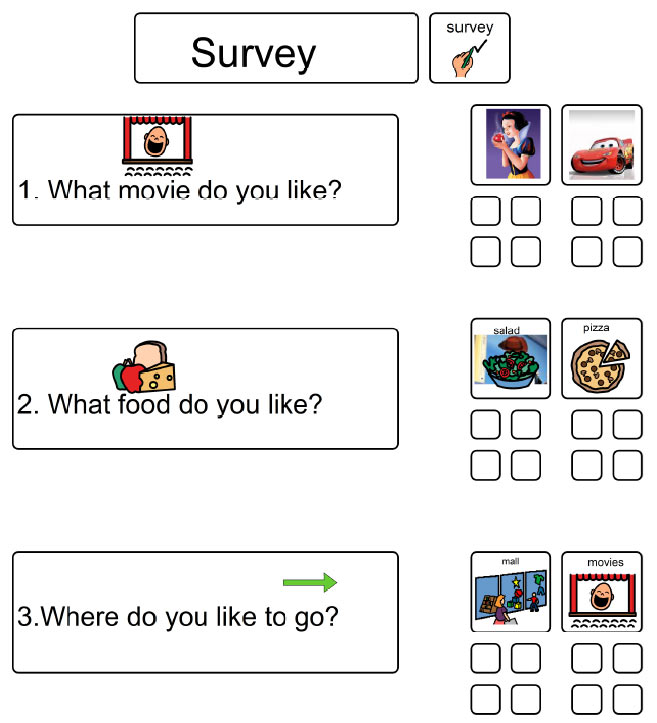 create a corresponding symbol-supported “interview form” and when someone answers a question the student is asked to check off the appropriate response on the form. (Click on Survey image or here to download interview form.)
create a corresponding symbol-supported “interview form” and when someone answers a question the student is asked to check off the appropriate response on the form. (Click on Survey image or here to download interview form.)
We have used a variety of voiced-output devices to create this activity. Most commonly, we use a Little Step-by-Step Communicator to record the sequenced messages. Other times we have created the script using an iPad communication app or a dedicated communication device. I have included a couple of examples of how we set up a script in Proloquo2Go, Book Creator and Pictello – some of our “go-to” apps for communication and social scripts.
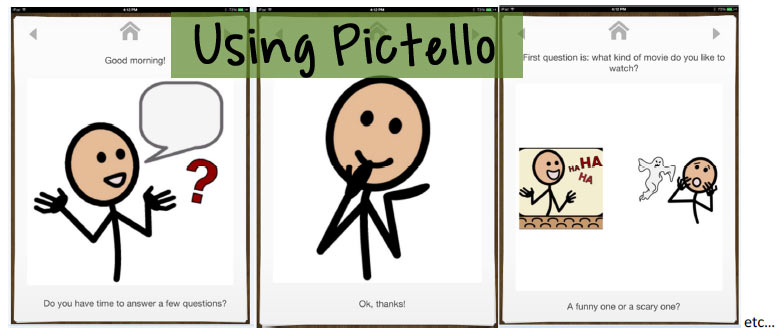
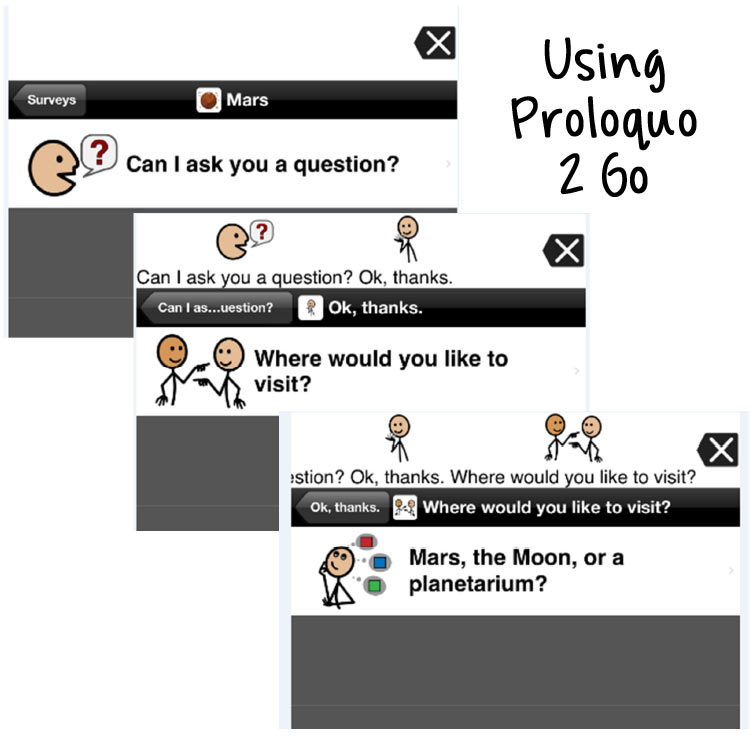
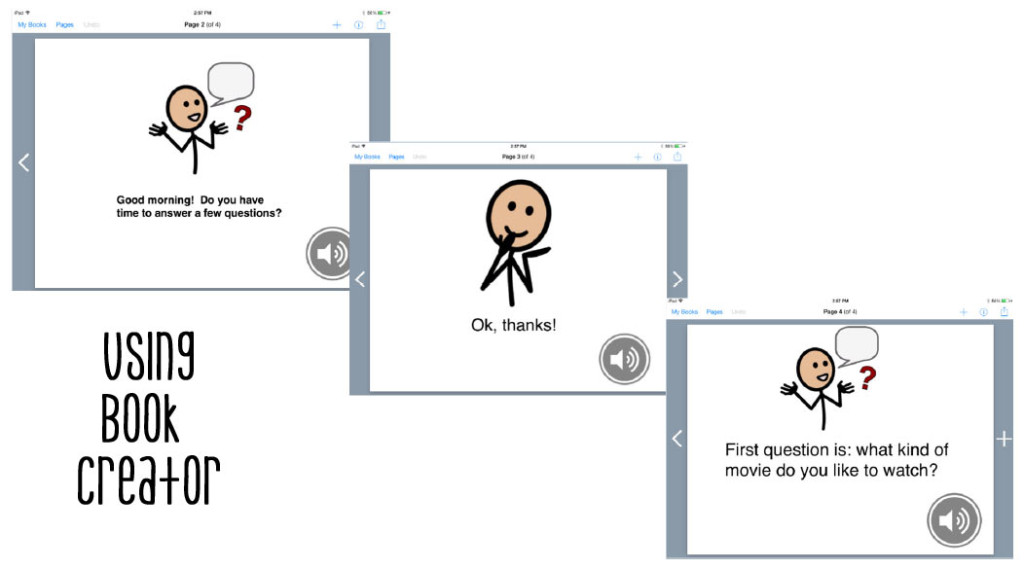
During the interview, one of the evaluators acts as a “communication accomplice” and provides the student with encouragement, support and prompts during the interview, as necessary. We have seen a wide gamut of student reactions to this particular activity. Some student jump right in and seem to know or quickly figure out what is expected of them, while others need continuing prompts and  encouragement from their “communication accomplice” and may not fully grasp the concept. For this reason we usually repeat the task more than once to give the student a chance to “practice” the first time. One of the things we have found with this activity is that although there is very little “skill” involved in completing the activity it can provide us with valuable information including:
encouragement from their “communication accomplice” and may not fully grasp the concept. For this reason we usually repeat the task more than once to give the student a chance to “practice” the first time. One of the things we have found with this activity is that although there is very little “skill” involved in completing the activity it can provide us with valuable information including:
- What is their initial response to the activity? To the device?
- Do they demonstrate increased success in completing the activity if they are given a chance to repeat it by interviewing a second or third person?
- What is their level of engagement throughout the activity?
- Is the student looking at their communication partner at any time during the interview?
- Do they demonstrate turn-taking skills or do they seem more intent on “hitting the switch/button”?
- How do they respond to prompts provided by their “communication accomplice”?
- What level of prompts are necessary to increase student engagement and success?
- Do they attend to the symbols supports on the interview form? (We find that some students will actually point to the symbols during this activity as if to answer the question themselves!)
- When presented with the interview form and asked to check off the person’s answer, how do they hold the pen? Do they mark the page appropriately?
- Are they successful in accessing the device we selected for the activity? Do they appear to need increased time to respond? Is the target sized appropriately?
- If different switch placements are tried during the activity, which one(s) appear to increase the student’s success?
Overall, we find that this activity can give us some initial insight into a student’s receptive communication and pragmatic skills and can also answer other questions regarding device access and placement for some students. It is usually a good activity to start off an evaluation when we are first meeting a student. It can be a way for us to start learning a bit more about one another — and it provides a lot of diagnostic information for such a simple and relatively low-stress activity. In addition, it provides the student’s team with an example of a valuable strategy (social scripts) that can be used to increase a student’s engagement and participation a variety of ways throughout their day. The section below has links to highly recommended resources on social scripts.
- Can We Chat? Co-planned Sequenced Social Scripts By Caroline Musselwhite and Linda Burkhart
- Sample Sequenced Social Scripts
- Little Step-by-Step Communicator
- Proloquo2Go
- Pictello
- Book Creator
::::::::::::::::::::::::::::::::::::::::::::::::::::::::::::::::::::::::::::
Jeanne received her M.A. in 1998 from University of Massachusetts at Amherst. She lives in Amherst with her husband, three daughters and a flock of backyard chickens. You can find Jeanne on the Facebook page she manages for the Collaborative Center for Assistive Technology and Training (CCATT) or on Twitter @jeannetuthill.
Filed under: PrAACtical Thinking
Tagged With: assessment, CCATT, interview, Jeanne Tuthill
This post was written by Carole Zangari

